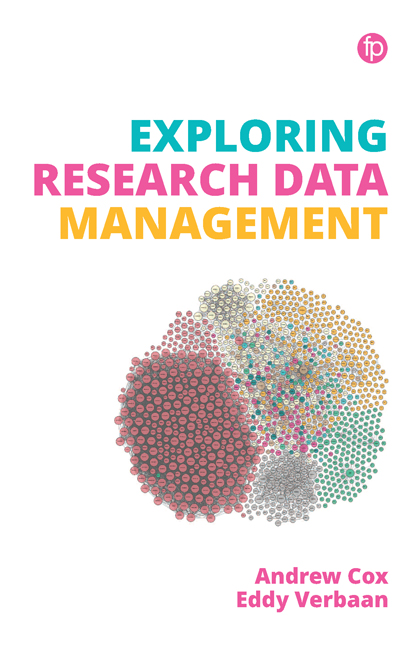Book contents
- Frontmatter
- Contents
- List of tables and figures
- 1 Introducing Research Data Management
- 2 The Social Worlds of Research
- 3 What Are Research Data?
- 4 Case Study of RDM in an Environmental Engineering Science Project
- 5 RDM: Drivers and Barriers
- 6 RDM as a Wicked Challenge
- 7 Research Data Services
- 8 Staffing a Research Data Service
- 9 Requirements Gathering for a Research Data Service
- 10 Institutional Policy and the Business Case for Research Data Services
- 11 Support and Advice for RDM
- 12 Practical Data Management
- 13 Data Management Planning
- 14 Advocacy for Data Management and Sharing
- 15 Training Researchers and Data Literacy
- 16 Infrastructure for Research Data Storage and Preservation
- 17 Evaluation of RDS
- 18 Ethics and Research Data Services
- 19 A Day in the Life Working in an RDS
- 20 Conclusion: the Skills and Mindset to Succeed in RDM
- Index
17 - Evaluation of RDS
Published online by Cambridge University Press: 21 September 2019
- Frontmatter
- Contents
- List of tables and figures
- 1 Introducing Research Data Management
- 2 The Social Worlds of Research
- 3 What Are Research Data?
- 4 Case Study of RDM in an Environmental Engineering Science Project
- 5 RDM: Drivers and Barriers
- 6 RDM as a Wicked Challenge
- 7 Research Data Services
- 8 Staffing a Research Data Service
- 9 Requirements Gathering for a Research Data Service
- 10 Institutional Policy and the Business Case for Research Data Services
- 11 Support and Advice for RDM
- 12 Practical Data Management
- 13 Data Management Planning
- 14 Advocacy for Data Management and Sharing
- 15 Training Researchers and Data Literacy
- 16 Infrastructure for Research Data Storage and Preservation
- 17 Evaluation of RDS
- 18 Ethics and Research Data Services
- 19 A Day in the Life Working in an RDS
- 20 Conclusion: the Skills and Mindset to Succeed in RDM
- Index
Summary
Aims
The purpose of this chapter is to consider how to evaluate RDS and RDM.
Introduction
Evaluation is a controversial topic. On the one hand, it feels obvious that without clearly defined objectives it is impossible to say whether a set of activities are worthwhile. And if we do not collect some data about how we are performing against those objectives we do not know how well we are performing. Tools like SMART objectives reflect this thinking and encourage us to measure whether objectives have been met. At the same time, it may be difficult to define purposes, especially where complex, intangible values are being pursued. In such a context defining our purposes and defining valid measures, i.e. ones that actually measure what we want to achieve, are hard. Capturing data about our achievements, especially quantitative data, is likely to be problematic. At some point more complex measures break down because they are hard to collect and understand.
In the library world, for example, there is pressure to demonstrate the value of the library to student learning. But learning is such a complex construct that it is hard to see how it could ever easily be measured, in a totally valid way. Tools such as the LibQual survey, while widely used in libraries to measure service performance, only compare satisfaction against expectation, not learning itself. Other types of measure, such as the number of resources or even downloads, do not directly link to learning, only the levels of activity.
In addition, the question of evaluation has resonances with the debate around the new public management and neo-liberalisation (see Chapter 5). For many, the way that academia is increasingly run like a private organisation with crude quantitative measures of performance – ‘key performance indicators’ – erodes the university's true purpose to promote learning and research in their widest sense.
Nevertheless, it would be odd not to write about the evaluation of RDS/RDM here, even though the literature on the topic is actually surprisingly sparse. From a management perspective it makes sense to collect data about performance, even if it is purely for internal consumption within the RDS team.
- Type
- Chapter
- Information
- Exploring Research Data Management , pp. 159 - 172Publisher: FacetPrint publication year: 2018

